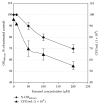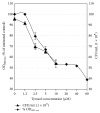Effect of Tyrosol and Farnesol on Virulence and Antibiotic Resistance of Clinical Isolates of Pseudomonas aeruginosa
- PMID: 26844228
- PMCID: PMC4710896
- DOI: 10.1155/2015/456463
Effect of Tyrosol and Farnesol on Virulence and Antibiotic Resistance of Clinical Isolates of Pseudomonas aeruginosa
Abstract
Mixed-species biofilms could create a protected environment that allows for survival to external antimicrobials and allows different bacterial-fungal interactions. Pseudomonas aeruginosa-Candida albicans coexistence is an example for such mixed-species community. Numerous reports demonstrated how P. aeruginosa or its metabolites could influence the growth, morphogenesis, and virulence of C. albicans. In this study, we investigated how the C. albicans quorum sensing compounds, tyrosol and farnesol, might affect Egyptian clinical isolates of P. aeruginosa regarding growth, antibiotic sensitivity, and virulence. We could demonstrate that tyrosol possesses an antibacterial activity against P. aeruginosa (10 µM inhibited more than 50% of growth after 16 h cultivation). Moreover, we could show for the first time that tyrosol strongly inhibits the production of the virulence factors hemolysin and protease in P. aeruginosa, whereas farnesol inhibits, to lower extent, hemolysin production in this bacterial pathogen. Cumulatively, tyrosol is expected to strongly affect P. aeruginosa in mixed microbial biofilm.
Figures


References
MeSH terms
Substances
LinkOut - more resources
Full Text Sources
Other Literature Sources
Medical

